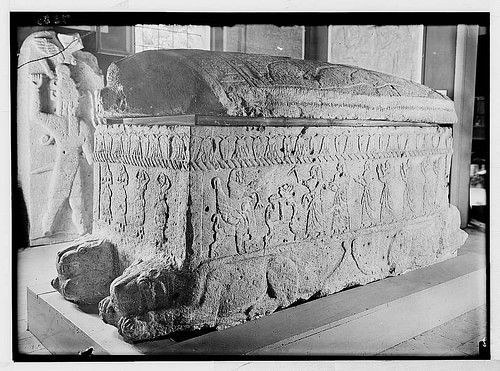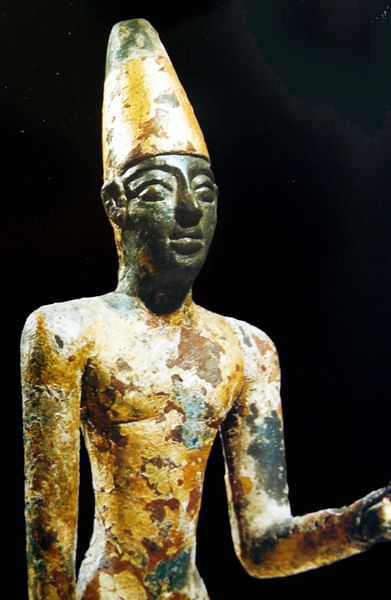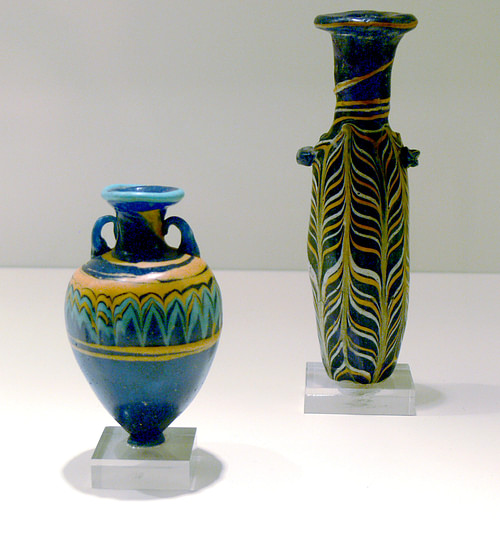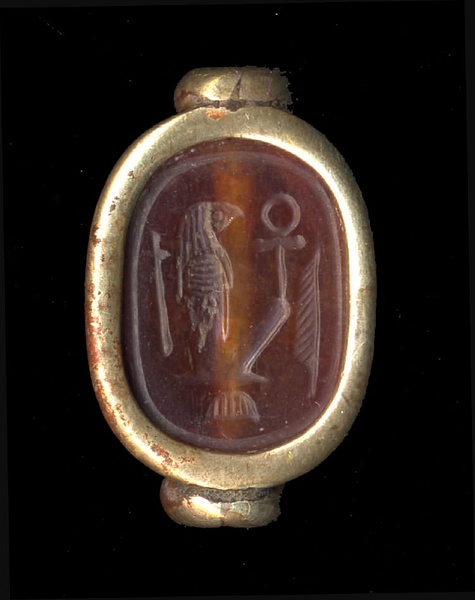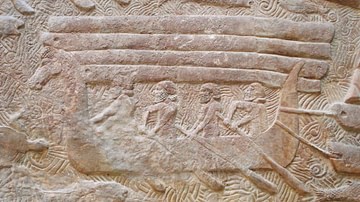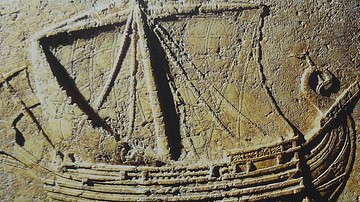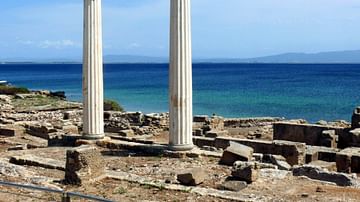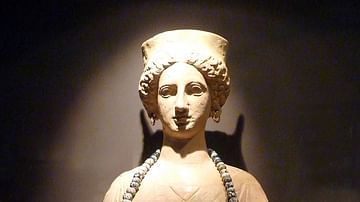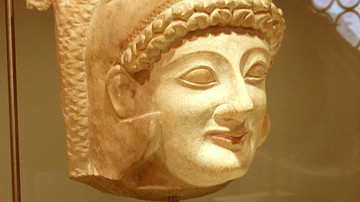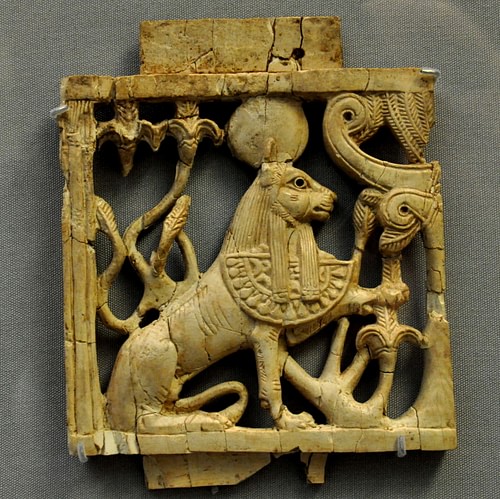
The art of the ancient Phoenicians, which flourished between the 19th and 4th centuries BCE, was exported throughout Mesopotamia and the ancient Mediterranean. Best known for their work on small decorative objects, Phoenician Artists skillfully blended influences from neighbouring cultures to produce a unique artistic heritage that has only relatively recently been brought out of the shadow of a wider Syrian art history. Intricately carved ivory panels, exquisite metal bowls, and fine colourful glassware are just some of the surviving art pieces from one of history's most neglected and forgotten cultures.
Artistic Influences
Phoenician art was influenced by that of its neighbours – Egypt, Mesopotamia, Anatolia, and the Aegean islands – with whom it had frequent contact through trade. The influence may be best seen in specific materials, for example, Aegean influence is most often seen in Phoenician pottery, Mesopotamian and Ugarit in metal work, and Egyptian in ivory work. Iconography, the clothing of figures, and the palm, lotus, and djed pillar motifs, for example, were borrowed from these contemporary cultures.
Another point of note is that Phoenician artists, unlike their contemporaries elsewhere, continued Bronze Age traditions long into the Iron Age; a fact which can make the accurate dating of certain works of art extremely difficult. Phoenician artists seem to have largely worked with ornamental objects, especially ivory plaques, seals, jewels, glassware, and metal bowls. These objects were exported or even made by Phoenician craftsman living in foreign cities and colonies; such was the appreciation of their skills and the finished product.
Phoenician Sculpture
Surviving examples of large-scale Phoenician sculpture in stone are few and far between, probably because any stone worthy of sculpture had to be imported and so the artform was not as popular as in other cultures. One notable piece is the torso from Sarafand (Sarepta) which dates to the 6th century BCE and depicts a male in pleated skirt and belt, wearing a crescent moon pendant. Stone relief carvings include the important aedicule (small shrine) from Sidon which represents a monument-type much-copied by later Carthaginian sculptors. It has two columns creating a central space in which sat two sphinxes and is topped by a winged sun disk. This and other types of grave markers and stelae were a popular medium for Phoenician sculptors. Decorative palmettes, sphinxes, winged-solar disks, and column motifs are frequently used in such Phoenician relief sculpture. Stone sculptures were originally painted in bright colours but usually sparingly in order to pick out features and specific details.
The 9th-6th-century BCE stele from Amrit is an interesting example of the Phoenician artist mixing influences as the male figure wears an Egyptian skirt and headgear while the lion walks on stones representing a mountain, a common feature of Assyrian art. The man is typical of most Phoenician figures in all art forms – viewed from the side, both feet are flat on the ground, arms either hang at the sides or one arm is bent to hold an object, and the face stares impassively forward.
Finally, perhaps the most outstanding piece which survives from Phoenician sculpture is the 13th-12th-century BCE stone sarcophagus of King Ahiram of Byblos. The rectangular coffin is surrounded by a frieze of lotus buds and flowers, has crouching lions protruding from each base corner, and carries relief scenes of a procession and seated figure, perhaps Ahiram himself, and mourning women.
Bronze figurines up to 20 cm tall have been much better survivors than larger-scale works but these are often difficult to distinguish from those produced in other Syrian cultures. They are generally crude in execution but have individualistic features. Several are from Aleppo and date to the 9th and 8th century BCE. Female figures are more common and typically wear a long tunic. Male figurines often have one arm raised and wear a conical hat. Some statuettes, such as those found at the Temple of Obelisks at Byblos, were covered in gold leaf.
Phoenician Ivories
Phoenician ivory plaques have been found in Mesopotamian cities (especially Nimrud), the Greek islands, and central Italy. Only a very few have been discovered at Phoenician sites but those exported are identified by the incision of Phoenician letters and ended up where they did because the Phoenicians traded them, gave them as tribute (or were war booty in the case of Assyria), or produced them on location in resident workshops. The plaques were used as decoration for walls, altars, incense burners, and items of furniture. The earliest date to the 9th century BCE and most are rectangular, carved in high relief, sometimes with gaps carved right through the piece. Lions, sphinxes, a winged-goddess, and a woman at a window are the most common subjects. As with relief sculpture in stone, they display influences from both Egypt and Assyria.
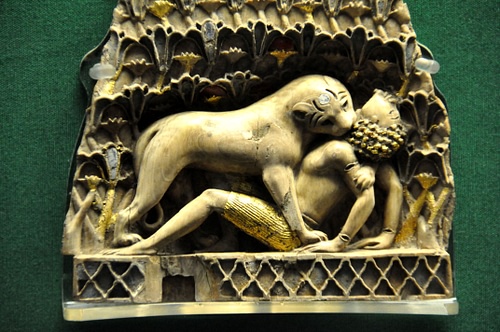
Precious Metal Bowls
Phoenician artists were known in antiquity for their fine metalwork, famously, Achilles presents a beautiful silver crater from Phoenician Sidon as a prize for the funeral games of Patroclus in Homer's Iliad. Another case is Hiram of Tyre who was employed by Solomon to create two huge decorated bronze pillars and a 4.5-metre diameter bronze basin with groups of oxen as feet to adorn his temple at Jerusalem. On a more modest scale, Phoenician artists made highly crafted bowls made from bronze, silver, and gold. Produced during the 8th and 7th century BCE, surviving examples have been found as far afield as Nimrud, Delphi, and Salerno in Italy. Many examples carry Phoenician inscriptions, greatly helping to identify the origin of these highly transportable goods.
The subject matter of the embossed reliefs on these bowls is typical of the Phoenician tradition of mixing cultural influences from Mesopotamia, Greece, and Egypt into a single object. A central medallion is common on the interior, as are concentric bands of decoration. Geometrical and floral motifs prevail but, once again, sphinxes, animals, and human figures also appear. To describe but one example, a bronze bowl found at Olympia has an eight-pointed star and rosettes in the central medallion. Within two decorative bands runs a frieze of scenes where figures play music, perform religious ceremonies, and one figure kills a griffin. Each scene is divided by a nude standing female figure, probably a goddess. The bowl is typical of Phoenician art with a mix of influences but adapted and made highly decorative.

Other Minor Arts
Phoenician cities were great exporters of glassware, so much so that the ancients (incorrectly) attributed its invention to them. The Phoenicians actually learnt the techniques from the Egyptians but were able to improve them to produce fine transparent glass. Despite this, artists seem to have preferred working with opaque coloured glass (which has the appearance of ceramic) to produce bottles, jars and bowls. The most common shape was the alabastron and amphora form but in miniature and used for perfumes. The most common form of decoration is stripes of blues (from cobalt or copper) and yellows (from iron oxide), punctuated by zig-zags.
Terracotta figurines (especially females) were produced, rather primitive in execution, often lavishly painted, and found mostly in grave contexts. Pottery, unfortunately, suffered from a lack of good clay. A common form was jugs, which usually have a lip, and the finest are made with a red-burnished finish. Few vessels carry any decoration, and if so, it is merely achieved via incised simple geometric shapes and lines.
Phoenician artists carved seals, especially scarab seals from semi-precious stones where the base is incised with names and decorative devices. Not only used as seals they were also carried as amulets and worn as rings and pendants. Once again sphinxes, winged deities, and solar disks are common. Finally, jewellery was also produced, often in gold or glass, and finds include necklaces, bracelets, pectorals, pins, earrings, and medallions. Some of the gold examples have repoussé decoration. Agate, onyx, and crystal were also used to produce beads for jewellery whilst small circular glass plaques were pierced with holes so that they might be sewn onto clothing.
Conclusion
Phoenician art spread to its colonies throughout the Mediterranean from the 8th century BCE and none more so than at the most successful Phoenician off-shoot: Carthage. Artists there were strongly influenced by and perpetuated Phoenician styles and subject matter up to the 2nd century BCE. Meanwhile, with the rise of Greece from the 5th century BCE, Phoenician art in the homeland became increasingly Hellenized as it continued its eclectic path towards mixed forms, which led to such oddities as Egyptian anthropoid sarcophagi with very Greek-looking faces carved on their exteriors. Long famous as traders and sailors, the Phoenicians, then, are slowly, as more and more of their art is discovered and known pieces are correctly attributed, gaining wider recognition as having been capable of producing just as fine art pieces as their contemporaries in Egypt and Mesopotamia.
